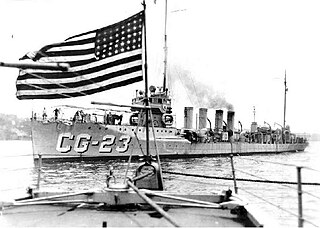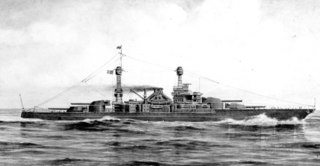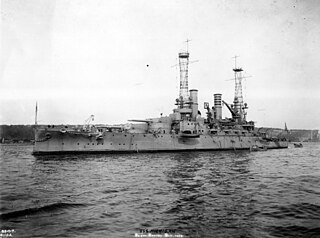
The Montana-class battleships were planned as successors of the Iowa class for the United States Navy, to be slower but larger, better armored, and with superior firepower. Five were approved for construction during World War II, but changes in wartime building priorities resulted in their cancellation in favor of continuing production of the Essex-class aircraft carrier and Iowa class before any Montana class keels were laid.

USS Maine was a United States Navy ship that sank in Havana Harbor in February 1898, contributing to the outbreak of the Spanish–American War in April. American newspapers, engaging in yellow journalism to boost circulation, claimed that the Spanish were responsible for the ship's destruction. The phrase "Remember the Maine! To hell with Spain!" became a rallying cry for action. Although the Maine explosion was not a direct cause, it served as a catalyst that accelerated the events leading up to the war.

USS Kentucky (BB-66) was an uncompleted battleship originally intended to be the second ship of the Montana class. However, the urgent need for more warships at the outbreak of World War II and the U.S. Navy's experiences in the Pacific theater led it to conclude that rather than battleships larger and more heavily armed than the Iowa class, it quickly needed more fast battleships of that class to escort the new Essex-class aircraft carriers being built. As a result, hulls BB-65 and BB-66 were reordered and laid down as Iowa-class battleships in 1942.

Illinois (BB-65) was an uncompleted battleship originally intended to be the first ship of the Montana class. However, the urgent need for more warships at the outbreak of World War II and the U.S. Navy's experiences in the Pacific theater led it to conclude that rather than battleships larger and more heavily armed than the Iowa class, it quickly needed more fast battleships of that class to escort the new Essex-class aircraft carriers being built. As a result, hulls BB-65 and BB-66 were reordered and laid down as Iowa-class battleships in 1942. As such, she was intended to be the fifth member of the Iowa-class constructed, and the fourth navy ship to be named in honor of the 21st US state.
The "maximum battleships", also known as the "Tillman Battleships", were a series of World War I-era design studies for extremely large battleships, prepared in late 1916 and early 1917 to the order of Senator "Pitchfork" Benjamin Tillman by the Bureau of Construction and Repair (C&R) of the United States Navy. The Navy was not interested in the designs and drew them up to win support from the Committee on Naval Affairs, on which Tillman sat. Nevertheless, they helped influence design work on the Pennsylvania and first South Dakota classes of battleships. The plans prepared for the senator were preserved by C&R in the first of its "Spring Styles" books, where it kept various warship designs conceptualized between 1911 and 1925.

The Nevada class comprised two dreadnought battleships—Nevada and Oklahoma—built for the United States Navy in the 1910s. They were significant developments in battleship design, being the first in the world to adopt "all or nothing" armor, a major step forward in armor protection because it emphasized protection optimized for long-range engagements before the Battle of Jutland demonstrated the need for such a layout. They also introduced three-gun turrets and oil-fired water-tube boilers to the US fleet. The two Nevadas were the progenitors of the standard-type battleship, a group that included the next four classes of broadly similar battleships that were intended to be tactically homogeneous.

The Colorado-class battleships were a group of four United States Navy super-dreadnoughts, the last of its pre-Treaty battleships. Designed during World War I, their construction overlapped the end of that conflict and continued in its immediate aftermath. Though all four keels were laid, only three ships were launched: Colorado, Maryland, and West Virginia. Washington was over 75% completed when she was canceled under the terms of the Washington Naval Treaty in 1922. As such, the 16" Colorado-class ships were the last and most powerful battleships built by the US Navy until the North Carolina class entered service on the eve of World War II.

The Virginia class of pre-dreadnought battleships were built for the United States Navy in the early 1900s. The class comprised five ships: Virginia, Nebraska, Georgia, New Jersey, and Rhode Island. The ships carried a mixed-caliber offensive battery of four 12-inch (305 mm) and eight 8-inch (203 mm) guns; these were mounted in an uncommon arrangement, with four of the 8-inch guns placed atop the 12-inch turrets. The arrangement proved to be a failure, as the 8-inch guns could not be fired independently of the 12-inch guns without interfering with them. Additionally, by the time the Virginias entered service, the first "all-big-gun" battleships—including the British HMS Dreadnought—were nearing completion, which would render mixed battery ships like the Virginia class obsolescent.

The Florida-class battleships of the United States Navy comprised two ships: Florida and Utah. Launched in 1910 and 1909 respectively and commissioned in 1911, they were slightly larger than the preceding Delaware class design but were otherwise very similar. This was the first US battleship class in which all ships received steam turbine engines. In the previous Delaware-class, North Dakota received steam turbine propulsion as an experiment while Delaware retained triple-expansion engines.

The Tucker class of destroyers was a ship class of six ships designed by and built for the United States Navy shortly before the United States entered World War I. The Tucker class was the fourth of five classes of destroyers that were known as the "thousand tonners", because they were the first U.S. destroyers over 1,000 long tons (1,016 t) displacement.

William Ledyard Rodgers was a vice admiral of the United States Navy. His career included service in the Spanish–American War and World War I, and a tour as President of the Naval War College. Rodgers was also a noted historian on military and naval topics, particularly relating to ancient naval warfare.

Design A-150, popularly known as the Super Yamato class, was a planned class of battleships for the Imperial Japanese Navy. In keeping with the Navy's long tradition, they were designed to be qualitatively superior to battleships that might be faced in battle, such as those from the United States or Great Britain. As part of this, the class would have been armed with six 51-centimeter (20.1 in) guns, the largest weapons carried aboard any warship in the world. Design work on the A-150s began after the preceding Yamato class in 1938–1939 and was mostly finished by early 1941, when the Japanese began focusing on aircraft carriers and other smaller warships in preparation for the coming conflict. No A-150 would ever be laid down, and many details of the class' design were destroyed near the end of the war.
Fleet problem is the term used by the United States Navy to describe each of 27 naval exercises. The initial 21 of these were conducted between 1923 and 1940. They are labeled with Roman numerals, from Fleet Problem I through Fleet Problem XXI. A 22nd Fleet Problem exercise, scheduled for 1941, was canceled because of World War II. After this, Fleet Problems underwent a prolonged hiatus, with other names being used to describe such naval exercise. However, the term was revived in 2015 or 2016 under Admiral Scott H. Swift, and Fleet Problem XXIII was held by the Pacific Fleet, with Fleet Problems XXIV through XXVIII occurring over the following years.
The United States Navy's Bureau of Ships (BuShips) was established by Congress on 20 June 1940, by a law which consolidated the functions of the Bureau of Construction and Repair (BuC&R) and the Bureau of Engineering (BuEng). The new bureau was to be headed by a chief and deputy-chief, one selected from the Engineering Corps and the other from the Construction Corps. The chief of the former Bureau of Engineering, Rear Admiral Samuel M. "Mike" Robinson, was named BuShips' first chief, while the former chief of the Bureau of Construction & Repair, Rear Admiral Alexander H. Van Keuren, was named as BuShips' first Deputy-Chief. The bureau's responsibilities included supervising the design, construction, conversion, procurement, maintenance, and repair of ships and other craft for the Navy; managing shipyards, repair facilities, laboratories, and shore stations; developing specifications for fuels and lubricants; and conducting salvage operations.

The first South Dakota class was a group of six battleships that were laid down in 1920 for the U.S. Navy, but were never completed. They would have been the largest, most heavily armed and armored battleships in the world and, designed to achieve 23 knots, represented an attempt to catch up with the increasing fleet speeds of its main rivals, the British Royal Navy and Imperial Japanese Navy.

USCGC Yamacraw (WARC-333) was a United States Coast Guard Cable Repair Ship. The ship was built for the Army Mine Planter Service as U. S. Army Mine Planter Maj. Gen. Arthur Murray (MP-9) delivered December 1942. On 2 January 1945 the ship was acquired by the Navy, converted to an Auxiliary Minelayer and commissioned USS Trapper (ACM-9) on 15 March 1945. Trapper was headed to the Pacific when Japan surrendered. After work in Japanese waters the ship headed for San Francisco arriving there 2 May 1946 for transfer to the Coast Guard.

The Lexington-class battlecruisers were officially the only class of battlecruiser to ever be ordered by the United States Navy. While these six vessels were requested in 1911 as a reaction to the building by Japan of the Kongō class, the potential use for them in the U.S. Navy came from a series of studies by the Naval War College which stretched over several years and predated the existence of the first battlecruiser, HMS Invincible. The fact they were not approved by Congress at the time of their initial request was due to political, not military considerations.

The South Carolina-class battleships, also known as the Michigan class, were built during the first decade of the twentieth century for the United States Navy. Named South Carolina and Michigan, they were the first American dreadnoughts—powerful warships whose capabilities far outstripped those of the world's older battleships.

The Xanthus-class repair ships were a class of five auxiliary ships built for the United States Navy and Royal Navy. Ships of the class served in a diverse range of environments in varying capacities during both World War II and the Korean War. Xanthus-class ships were in commission between 1945–1955.